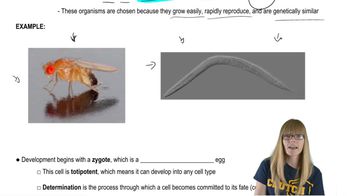How do comparisons between genomes of related species help refine gene annotation?
Table of contents
- 1. Introduction to Genetics51m
- 2. Mendel's Laws of Inheritance3h 37m
- 3. Extensions to Mendelian Inheritance2h 41m
- 4. Genetic Mapping and Linkage2h 28m
- 5. Genetics of Bacteria and Viruses1h 21m
- 6. Chromosomal Variation1h 48m
- 7. DNA and Chromosome Structure56m
- 8. DNA Replication1h 10m
- 9. Mitosis and Meiosis1h 34m
- 10. Transcription1h 0m
- 11. Translation58m
- 12. Gene Regulation in Prokaryotes1h 19m
- 13. Gene Regulation in Eukaryotes44m
- 14. Genetic Control of Development44m
- 15. Genomes and Genomics1h 50m
- 16. Transposable Elements47m
- 17. Mutation, Repair, and Recombination1h 6m
- 18. Molecular Genetic Tools19m
- 19. Cancer Genetics29m
- 20. Quantitative Genetics1h 26m
- 21. Population Genetics50m
- 22. Evolutionary Genetics29m
15. Genomes and Genomics
Comparative Genomics
Problem 16
Textbook Question
In humans, Duchenne muscular dystrophy is caused by a mutation in the dystrophin gene, which resides on the X chromosome. How would you create a mouse model of this genetic disease?
 Verified step by step guidance
Verified step by step guidance1
Understand the genetic basis of Duchenne muscular dystrophy (DMD): DMD is caused by mutations in the dystrophin gene, which is located on the X chromosome. This gene encodes the dystrophin protein, essential for muscle function. A mouse model would need to mimic this mutation to study the disease.
Select the appropriate genetic engineering technique: Techniques such as CRISPR-Cas9 or homologous recombination can be used to introduce a mutation into the dystrophin gene in mice. CRISPR-Cas9 is often preferred due to its precision and efficiency.
Design the mutation: Decide on the specific mutation to introduce into the mouse dystrophin gene. This could be a deletion, insertion, or point mutation that mimics the human DMD mutation. Ensure the mutation disrupts the dystrophin protein function in a way similar to the human condition.
Introduce the mutation into the mouse genome: Use the chosen genetic engineering technique to modify the dystrophin gene in mouse embryonic stem cells or zygotes. For example, with CRISPR-Cas9, design guide RNAs to target the dystrophin gene and introduce the mutation using a repair template or by inducing non-homologous end joining (NHEJ).
Validate and breed the mouse model: Confirm the presence of the mutation using molecular techniques such as PCR and sequencing. Breed the genetically modified mice to establish a stable line. Study the phenotype to ensure it replicates the symptoms of Duchenne muscular dystrophy, such as muscle weakness and degeneration.
 Verified video answer for a similar problem:
Verified video answer for a similar problem:This video solution was recommended by our tutors as helpful for the problem above
Video duration:
1mPlay a video:
Was this helpful?
Key Concepts
Here are the essential concepts you must grasp in order to answer the question correctly.
Duchenne Muscular Dystrophy (DMD)
Duchenne muscular dystrophy is a severe genetic disorder characterized by progressive muscle degeneration and weakness, primarily affecting boys. It is caused by mutations in the dystrophin gene, which is crucial for maintaining the structural integrity of muscle cells. Understanding DMD is essential for developing models that replicate the disease's pathology.
X-Linked Inheritance
Duchenne muscular dystrophy is inherited in an X-linked recessive manner, meaning the gene responsible is located on the X chromosome. Males, having one X and one Y chromosome, are more severely affected, while females can be carriers with milder symptoms. This concept is vital for understanding the genetic basis of DMD and its implications for creating animal models.
Recommended video:
Guided course

X-Inactivation
Mouse Models in Genetics
Mouse models are essential tools in genetics research, allowing scientists to study human diseases in a controlled environment. To create a mouse model of DMD, researchers typically use techniques like gene editing (e.g., CRISPR-Cas9) to introduce mutations in the dystrophin gene, mimicking the human condition. These models help in understanding disease mechanisms and testing potential therapies.
Recommended video:
Guided course

Genetics of Development
Related Videos
Related Practice
Textbook Question
406
views


